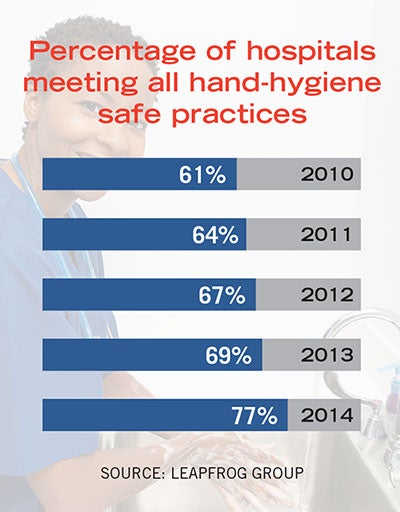Hospitals show hand hygiene progress
 |
| Graph shows steady increase in hospitals that take extensive hand-hygiene measures. |
Hospitals demonstrated significant progress in the adoption of important hand-hygiene practices, according to the results of a recent hospital safety and quality survey.
The 2014 Leapfrog Hospital Survey shows that the percentage of hospitals that meet all 10 of Leapfrog’s hand-hygiene safe practices increased to 77 percent in 2014 from 69 percent in 2013.
This one-year increase is the biggest since 2010. Before 2014, the percentage of hospitals meeting all hand-hygiene safe practices as defined by Leapfrog rose incrementally from 61 percent in 2010 to 69 percent in 2013.
“It is good to see that improvement in 2014, especially since it’s more than we’ve seen in the previous few years,” says Erica Mobley, director of communications, the Leapfrog Group, Washington, D.C.
To qualify for Leapfrog’s standard for proper hand hygiene, hospitals must adhere to 10 recommended safe practices. Key provisions include:
• Hospitalwide hand-hygiene education and training.
• Submitting a report on hand-hygiene recommendations and results to the hospital’s board of directors.
• Holding clinical leadership, senior administrative leadership and patient safety officers accountable for hand hygiene.
• Documenting expenditures related to hand-hygiene education.
• Implementing or monitoring performance improvement programs related to the prevention of health care-associated infections (HAIs) through hand-hygiene compliance.
Mobley says that while it is difficult to pinpoint what caused the substantial increase in hospitals’ meeting the hand-hygiene qualifications, she offered a possible explanation.
One likely driver of improvement is that the importance of exercising proper hand hygiene by clinical staff in hospitals and health care facilities has become a higher priority in recent years as a simple, economic way to prevent HAIs.
“I definitely think hand hygiene is proving to be the best way to prevent the spread of infection, which obviously is something that all hospitals are concerned with,” she says.
“Aside from the cost of soap and sanitizer, it’s an inexpensive thing to focus on and can save a hospital a lot of money by doing something so simple that can reduce the infection rate,” she says.
Guidelines from the Centers for Disease Control and Prevention, Atlanta, state that health care providers should practice hand hygiene before patient contact; after contact with blood, body fluids or contaminated surfaces; before invasive procedures; and after removing gloves.
The Leapfrog Group is an independent, nonprofit watchdog group founded in 2000 by employers and other purchasers of health benefits to collect and report data from U.S. hospitals.




